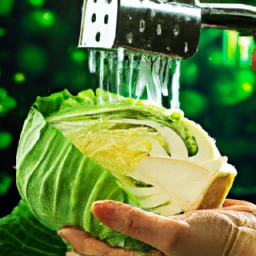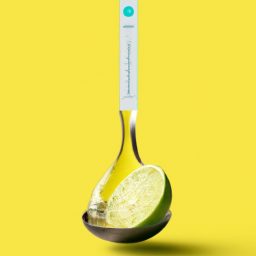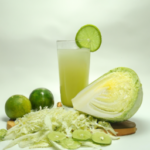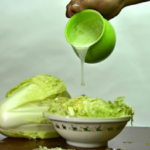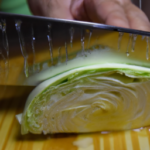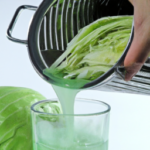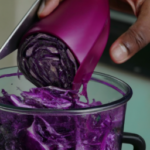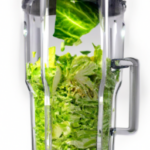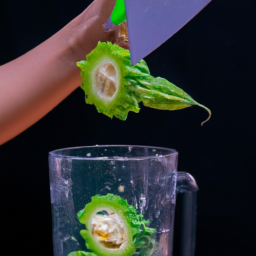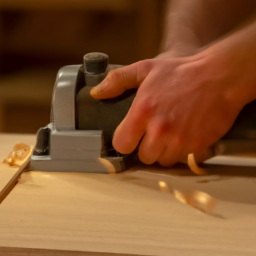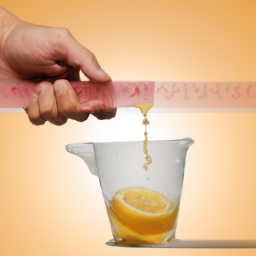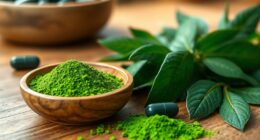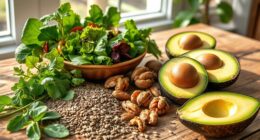I love starting my day with a refreshing glass of vegetable juice, and one of my favorite ingredients to use is cabbage. Packed with important nutrients like vitamin C, vitamin K, and fiber, cabbage is a great choice for juicing. However, if you’re new to juicing cabbage, it can seem a little intimidating at first.
That’s why I’m here to guide you through the process step by step. Picture this: a bright green head of cabbage, freshly washed and ready to be turned into a delicious and nutritious juice. With just a few simple steps, you can transform this humble vegetable into a drink that’s both tasty and good for you.
In this article, I’ll walk you through everything you need to know to juice a cabbage, from gathering your equipment to cleaning up when you’re finished. So grab your juicer and let’s get started!
Key Takeaways
- Cabbage is a highly nutritious vegetable that can be juiced to reap numerous health benefits.
- Proper washing, chopping, and juicing techniques can ensure maximum juice yield and nutrient retention.
- Maintenance and safety precautions when using and cleaning a juicer are important to prevent mishaps and damage.
- Cabbage juice can be used in a variety of recipes and should be consumed immediately or refrigerated for up to 24 hours to maximize nutritional benefits.
Gather Necessary Equipment
You’ll need to grab a sharp knife, a cutting board, and a sturdy juicer to get started on juicing that cabbage. Before you begin, it’s important to ensure that your equipment is well-maintained and in good working condition.
Check your knife for any dull spots or nicks, and sharpen it if necessary. Make sure your cutting board is clean and free of any debris that could get in the way while you’re slicing the cabbage. As for your juicer, give it a quick once-over to make sure all the parts are securely in place and functioning properly.
It’s also important to take some safety precautions while handling your equipment. Always use your knife on a stable surface to prevent accidental slips or cuts. Keep your fingers and other body parts away from the sharp blade while you’re using it.
When using the juicer, make sure to follow the manufacturer’s instructions and keep your hands and other objects away from the moving parts. With your equipment in good working order and safety precautions taken care of, you’re ready to move on to the next step – washing the cabbage.
Wash the Cabbage
Before getting started, it’s important to give the cabbage a good scrub under running water to ensure any dirt or grime is removed. This step not only ensures that the end product is clean and safe to consume, but also has added benefits.
Washing the cabbage can help remove any pesticide residues that may be present on the outer leaves and also helps to remove any harmful bacteria that may be present on the surface. Different washing methods can be used, such as soaking the cabbage in a bowl of water or using a vegetable brush to gently scrub the leaves.
It’s important to pay extra attention to the crevices between the leaves as dirt and grime can easily accumulate there. After washing, be sure to dry the cabbage thoroughly with a clean towel or paper towel before proceeding to the next step. By taking the time to properly wash the cabbage, you’re ensuring that the final product is not only delicious but also safe for consumption.
Now that the cabbage is clean and ready to go, the next step is to remove any wilted or damaged leaves before juicing.
Remove Wilted or Damaged Leaves
Once you’ve given the cabbage a good wash, take a closer look and gently pluck away any wilted or damaged leaves, revealing the crisp and vibrant ones underneath. It’s important to discard any unusable leaves before juicing as they may affect the taste and quality of the juice. Checking the freshness of the cabbage at this stage is also crucial. Fresh cabbage will have firm leaves that are tightly packed together, while old or stale cabbage will have looser, discolored leaves.
To make the juicing process easier and more efficient, it’s best to have a clean and uniform cabbage. A helpful way to do this is by chopping the cabbage into smaller pieces. But before we get to that, let’s move on to the next step in the process: removing the core.
Chop the Cabbage
Now that the wilted and damaged leaves have been removed, it’s time to give your cabbage a makeover by transforming it into bite-sized pieces resembling confetti, making it easier to process through the juicer like a breeze.
There are different ways to chop cabbage for juicing, but the most common is to use a sharp knife. Start by cutting the cabbage in half and then quartering it. Remove the hard center core, and then slice the cabbage into thin strips. Finally, chop the strips into small pieces.
Juicing cabbage is an excellent way to reap its numerous health benefits. Cabbage is rich in vitamin C, fiber, and antioxidants that help detoxify the body and improve digestion. Additionally, drinking cabbage juice regularly can lower cholesterol, reduce inflammation, and boost the immune system.
With your cabbage chopped and ready to go, it’s time to set up the juicer and get started on your juicing journey.
Set Up the Juicer
Now that I’ve chopped my cabbage, it’s time to assemble my juicer. I’ll start by following the manufacturer’s instructions to ensure that I put it together correctly.
Once it’s assembled, I’ll place the chopped cabbage into the juicer’s feeding chute. I’ll make sure to push it down firmly to extract as much juice as possible.
Assembling the Juicer
First things first, I gotta grab that juicer and get ready to make some magic happen! Before assembling the juicer, it’s important to ensure that it has been properly maintained and cleaned. A well-maintained juicer will provide better quality juice and last longer.
I also recommend keeping troubleshooting tips in mind, such as checking for clogs or uneven cutting blades, to avoid any mishaps during the process.
Once the juicer is ready to go, the next step is to place the chopped cabbage into the machine. But before we get to that, let’s make sure everything is set up correctly and ready to go.
Placing the Chopped Cabbage
You’re ready to add your chopped veggies into the juicer, so let’s get started!
First, take the juicing container and place it under the spout. This will collect the fresh cabbage juice as it is extracted.
Next, take your chopped cabbage and add it to the juicer chute. Make sure to push it down gently with the plunger to ensure all the cabbage is juiced.
Juicing benefits are numerous, and cabbage juice is no exception. It’s an excellent source of vitamins C, K, and B6, as well as folate and fiber. Drinking cabbage juice can aid in digestion, boost immunity, and even promote weight loss.
There are many cabbage juice recipes to choose from, from simple cabbage and carrot juice to more complex blends that include ginger, apple, and even pear.
With your cabbage chopped and ready to go, it’s time to begin juicing.
Begin Juicing
Okay, it’s time to start juicing! First, I’ll turn on the juicer and make sure it’s running smoothly.
Then, I’ll take my prepared cabbage and begin feeding it into the juicer. It’s important to take it slow and steady, to ensure the best quality juice and to avoid clogging the machine.
Let’s get started!
Starting the Juicer
Now, plug in the juicer and make sure it’s securely in place on a stable surface before turning it on. This step is crucial to avoid any accidents or spills while juicing.
If you’re new to juicing, it’s important to read the manual and learn about the different parts of the juicer and how to assemble and disassemble it. You should also familiarize yourself with the troubleshooting tips in case something goes wrong during the process.
Once you have the juicer set up, it’s time to select the cabbage juice recipe you want to make. There are several options to choose from, including plain cabbage juice, cabbage and apple juice, or cabbage and carrot juice. Each recipe has its own benefits and flavor, so it’s worth experimenting to find your favorite.
Now that you’re ready to start juicing, let’s move on to the next step of feeding the cabbage into the juicer.
Feeding the Cabbage into the Juicer
As you feed the leafy green into the juicer, feel the satisfying crunch of the vegetable being pulverized into a nutrient-rich liquid that will invigorate your body and mind. But before you begin, it’s important to choose the right type of juicer for cabbage. A masticating juicer is recommended as it is better at extracting juice from leafy greens compared to a centrifugal juicer. It grinds the cabbage, releasing more juice and retaining the nutrients.
When feeding the cabbage into the juicer, make sure to cut it into small pieces to avoid clogging the machine. It’s also important to avoid common mistakes such as overloading the juicer or not cleaning it properly after each use. To ensure maximum juice yield, push the cabbage slowly into the juicer, allowing the machine to extract as much juice as possible.
In the next section, we’ll discuss how to collect the juice that has been extracted from the cabbage.
Collect the Juice
First, you’re going to want to chop your cabbage into small pieces to make it easier to collect the juice. This will allow the juicer to extract the maximum amount of juice from the cabbage. It’s important to note that cabbage is a highly nutritious vegetable that’s packed with vitamins and minerals.
Drinking cabbage juice has numerous health benefits, including improved digestion, reduced inflammation, and lower blood pressure. Additionally, cabbage juice can be used in a variety of recipes, such as smoothies, soups, and dressings, to add flavor and nutrition.
Once you’ve fed the chopped cabbage into the juicer, you’ll need to collect the juice. This can be done by placing a container under the spout of the juicer. It’s important to note that the juice should be consumed immediately after juicing to ensure maximum nutritional benefits. However, if you wish to store the juice, it can be refrigerated in an airtight container for up to 24 hours.
In the next section, we’ll discuss how to serve or store the juice in more detail.
Serve or Store the Juice
Don’t miss out on the incredible health benefits of this nutrient-packed elixir – serve or store it properly to keep your body nourished and energized!
There are a variety of ways to add flavorings to your cabbage juice to make it more palatable. You can mix it with other juices, such as apple or carrot juice, to add sweetness and balance out the flavor. You can also add herbs and spices, such as ginger or turmeric, to give it a kick of flavor and extra health benefits.
If you don’t plan on drinking all of your cabbage juice right away, freezing it is a great option for later use. Simply pour the juice into a freezer-safe container and store it in the freezer for up to six months. When you’re ready to drink it, thaw it in the fridge overnight and give it a good shake before drinking.
Now that you’ve enjoyed your nourishing cabbage juice, it’s time to clean the juicer and get it ready for your next juicing session.
Cleaning the Juicer
Cleaning the juicer is like giving it a spa treatment – it deserves some TLC after working hard to extract all the goodness from your veggies. Here are some cleaning tips to ensure your juicer stays in tip-top shape:
-
Clean your juicer immediately after use to prevent any residue from drying and becoming harder to remove.
-
Use a soft-bristled brush to clean hard-to-reach areas of the juicer, such as the mesh filter and crevices.
-
Soak removable parts in warm soapy water for a few minutes to loosen any remaining residue before cleaning.
-
Avoid using abrasive cleaners or scrubbers, which can damage the juicer’s delicate parts.
One common mistake people make when cleaning their juicer is not taking it apart completely. This can lead to leftover pulp and juice buildup, which can cause the juicer to clog and affect its performance. By following these cleaning tips, you can ensure your juicer stays in great condition and continues to provide you with fresh, healthy juice.
Now that your juicer’s sparkling clean, it’s time to enjoy your fresh and healthy cabbage juice!
Enjoy Your Fresh and Healthy Cabbage Juice!
Now that we’ve cleaned our juicer, it’s time to enjoy the fruits of our labor! Well, in this case, the vegetable of our labor – cabbage! Drinking cabbage juice can have numerous health benefits, such as boosting digestion, improving skin health, and even aiding in weight loss. Plus, it’s a great way to incorporate more vegetables into your diet.
There are many different recipes for making cabbage juice, depending on your taste preferences and the ingredients you have on hand. One simple recipe is to juice half a cabbage with a few carrots and a small piece of ginger. Another option is to add some apple or pear for a sweeter flavor. Experiment with different combinations to find what works best for you. And remember, always drink your fresh juice right away to get the maximum benefits!
| Benefits of Drinking Cabbage Juice | Different Recipes for Making Cabbage Juice | Tips for Juicing Cabbage |
|---|---|---|
| – Boosts Digestion | – Cabbage, Carrot, Ginger | – Cut cabbage into small pieces |
| – Improves Skin Health | – Cabbage, Apple, Pear | – Use a slow juicer for best results |
| – Aids in Weight Loss | – Cabbage, Celery, Lemon | – Drink juice immediately after juicing |
Frequently Asked Questions
How long does cabbage juice stay fresh?
I store my cabbage juice in an airtight container in the fridge and it stays fresh for up to 3 days. Cabbage juice is a great source of vitamin C, potassium, and antioxidants, making it a nutritious addition to any diet.
Can you mix cabbage juice with other types of juice?
I’ve found that mixing cabbage juice with other juices can create some interesting flavor combinations. Pineapple adds sweetness, while apple adds tartness. Some people even mix it with carrot juice. It’s all about personal preference!
Are there any potential side effects of drinking cabbage juice?
Drinking cabbage juice may cause digestive issues such as bloating and flatulence, especially in large amounts. It may also trigger allergic reactions in some individuals. If experiencing discomfort, it is best to discontinue use and seek medical advice.
What are some other ways to use cabbage besides juicing it?
I love using cabbage in my cooking! There are so many delicious cabbage recipes out there, from coleslaw to stir-fries. Plus, cabbage is packed with nutritional benefits like vitamin C and fiber.
Is there a recommended time of day to drink cabbage juice for maximum benefits?
For maximum benefits, drink cabbage juice in the morning on an empty stomach. Best preparation methods include blending or juicing fresh cabbage and consuming an ideal serving size of 4-8 ounces per day. Evidence suggests it may improve digestion and boost immune function.
Conclusion
In conclusion, juicing cabbage is an easy and efficient way to add a nutritious boost to your daily routine. Not only is cabbage packed with vitamins and minerals, but it also contains antioxidants and anti-inflammatory properties that can benefit your overall health.
By following the simple steps outlined above, you can enjoy a delicious and refreshing glass of cabbage juice in no time. As the saying goes, "an apple a day keeps the doctor away,"but why not mix it up and add some cabbage juice to your diet as well?
With its numerous health benefits and easy preparation, juicing cabbage is a great way to promote a healthier lifestyle. So go ahead, give it a try and see the positive impact it can have on your well-being.
Ilana has been a vegan for over 10 years. She originally made the switch for health reasons, but soon found herself becoming more and more passionate about the ethical and environmental implications of a vegan lifestyle. Ilana is the author of The Graceful Kitchen, a blog all about veganism. She loves to cook up delicious and nutritious vegan meals, and share her recipes with others who are interested in leading a cruelty-free life. Ilana is also a strong advocate for using whole foods as the foundation of a healthy diet, and believes that going vegan is one of the best ways to achieve this.
